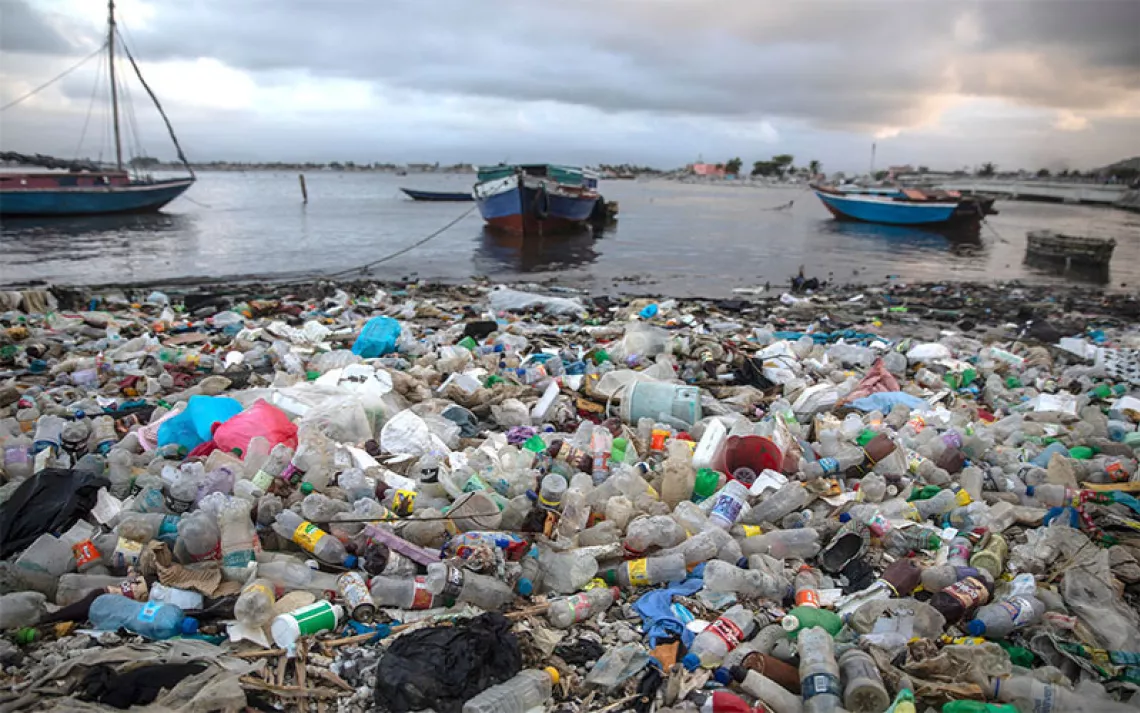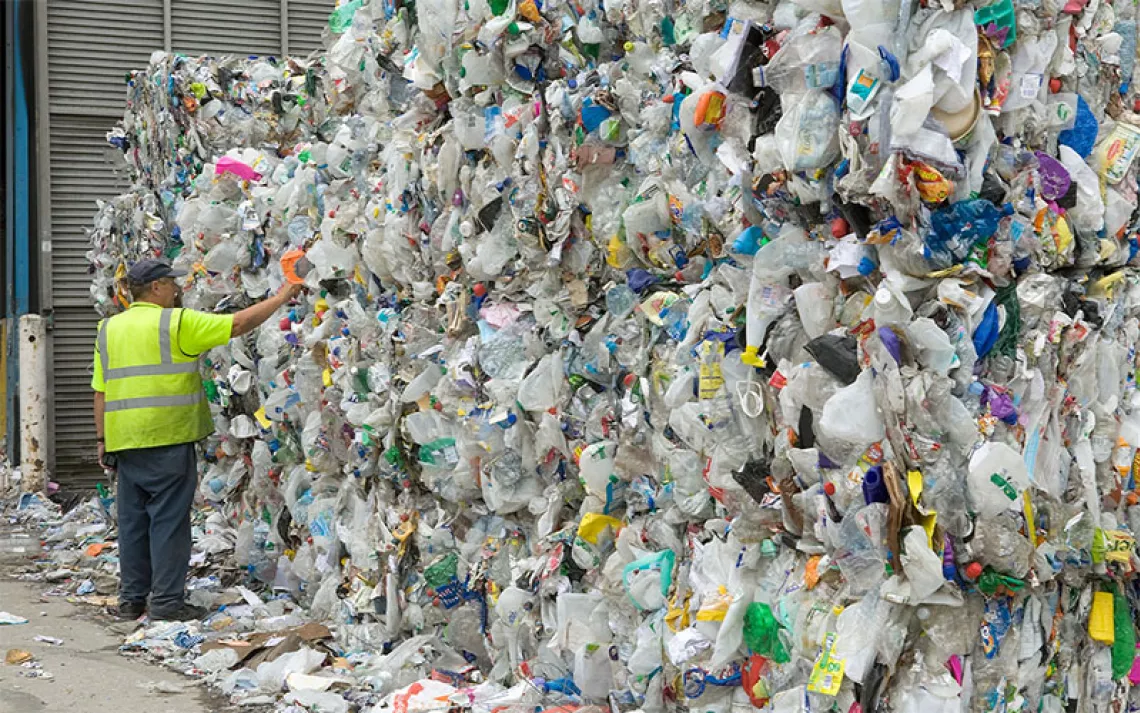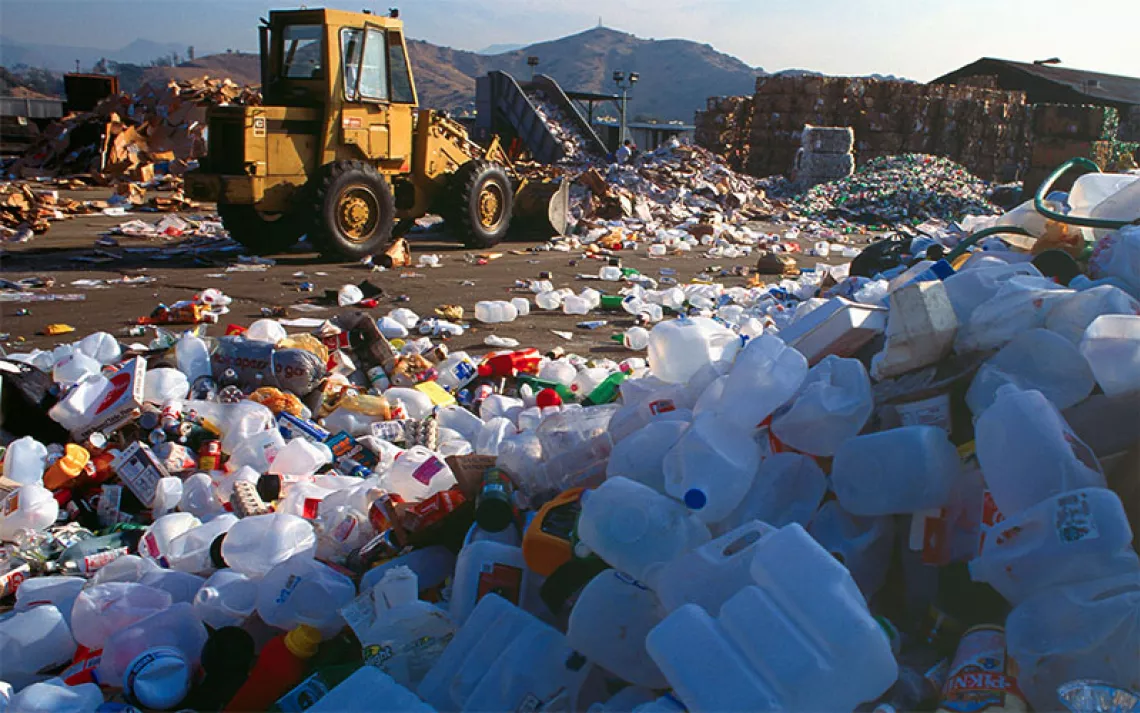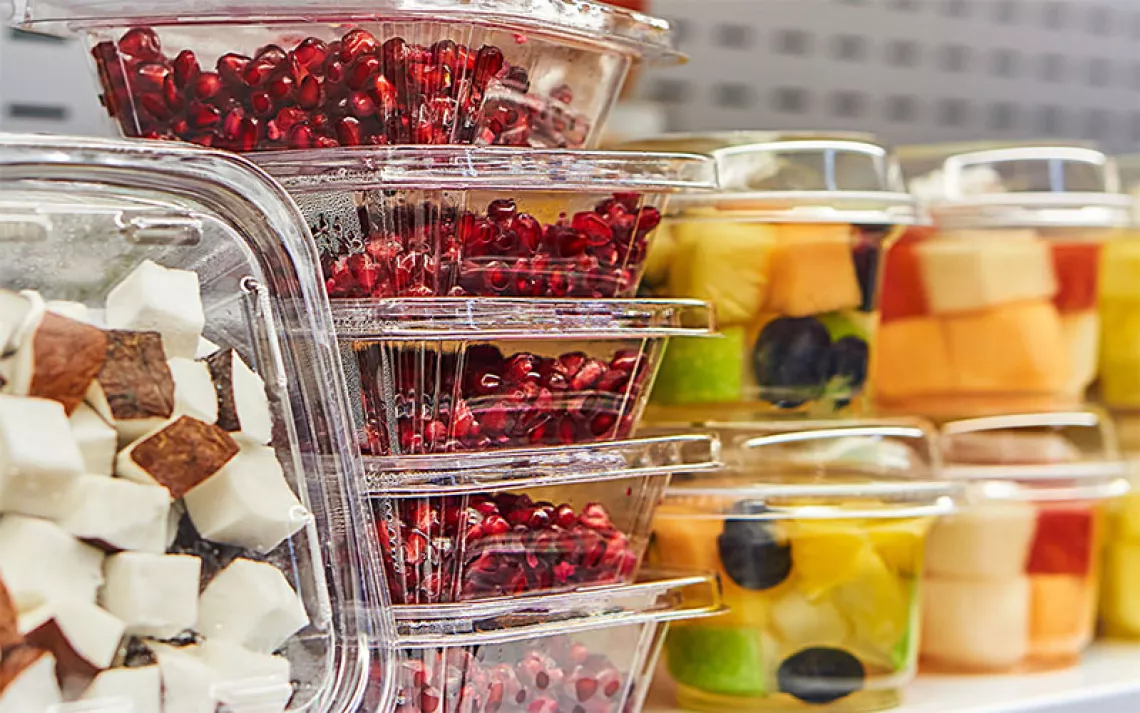ENVIRONMENT EXPLAINED
Not Fantastic: Our Plastic Buildings
Here's what you need to know about polyvinyl chloride, or PVC
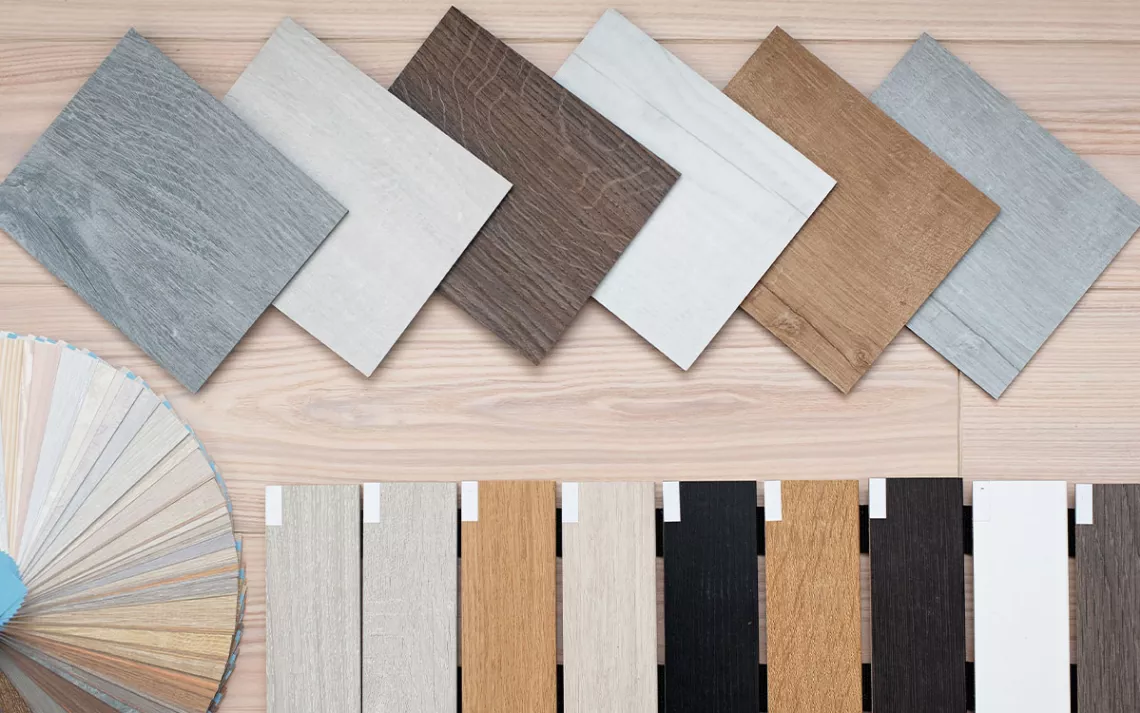
Photo by Adrian Calinescu/500px/Getty Images
You’ve seen it in the flooring aisle at big-box home improvement centers, or on HGTV. It’s called “resilient” flooring and it’s rugged, cheap, and easy to install. Tiles of the material come in patterns that look remarkably like stone or woodgrain, and they don’t require adhesives or grout. There’s only one problem: It’s made out of oil.
Building products like these are contributing to the deluge of plastic pollution while helping drive demand for fossil fuel extraction. The world is awash in petrochemical-based plastic stuff—microplastics are literally coursing through our bloodstreams—yet petrochemical production is poised to surge in the coming decades.
“The fossil fuel industry continues to look for alternate outlets for their fossil fuels. And as we're reducing use in the energy sector, they're dumping that into plastics,” says Rebecca Stamm, senior researcher at Habitable, a research organization that seeks to advance healthy building materials. According to the Beyond Petrochemicals campaign, there are over 100 proposals for new US petrochemical facilities in the queue. A lot of those plastics are going inside homes, schools, and other buildings. Building and construction accounts for 17 percent of plastic demand worldwide—the second-largest category after packaging.
Polyvinyl chloride, or PVC, has made its way inside and out: in windows, doors, and flooring; in siding, decking, and fencing. It’s used as plumbing pipe and in insulation for wiring. Other plastic products may be less obvious, such as spray foam insulation and synthetic carpeting. “Even people who have been in the material health world a long time don't necessarily think about carpet as plastic or paint as plastic,” says Stamm.
Fossil fuels provide both the raw materials for making plastic and the energy required to produce them. According to the International Energy Agency, petrochemicals will account for over a third of the growth in oil demand between now and 2030, and nearly half between now and 2050.
The growth of the petrochemical industry is terrible news for climate. A recent report from the Lawrence Berkeley National Laboratory estimates that plastics manufacturing produces four times as much carbon dioxide as the aviation industry each year, and that global carbon pollution from plastic production is on track to triple by 2050. The surge in petrochemicals is also bad news for anyone who spends time inside buildings.
“The number one use of PVC is building materials, which are often filled with a witch’s brew of toxic additives,” says Mike Schade, Mind the Store campaign director at Toxic-Free Future.
These additives include “worst in class” chemicals like phthalates, flame retardants, and per- and polyfluoroalkyl substances, a.k.a. PFAS. Phthalates are used to soften PVC in flexible flooring, shower curtains, and wall coverings. Flame retardants are added to plastic foam insulation. PFAS chemicals are often added to carpeting to improve stain resistance and paints to improve spread and gloss and reduce bubbling and peeling. An analysis by Habitable found that roughly 50 percent of paints sampled contained PFAS.
Furniture, paint, and carpeting can off-gas toxic chemicals over time. Exposure to even tiny amounts can increase health risks, says Schade. “Some of these chemicals are considered endocrine or hormone disrupting chemicals that interfere with processes that are critical for every bodily function you can think of.”
It’s not just building occupants who are at risk. “Highly hazardous chemicals are used in the production of vinyl, which pose serious risks to workers and environmental-justice communities where these sites are typically located,” says Schade. “It’s a classic case of environmental racism.”
The dangers of vinyl first came to light in the 1970s, when workers began developing rare liver cancers. Though the industry has cleaned up its act in some regards, reducing emissions and improving worker safety, the 19 US plants that make vinyl chloride and PVC resins collectively released 400,000 pounds of vinyl chloride into the air in 2021, burdening communities in Texas, Louisiana, Mississippi, Kentucky, Illinois, and New Jersey with toxic loads.
Plastic products also pollute the environment in other ways. Paints, for example, are a significant source of microplastic pollution in waterways and oceans. In addition, most PVC—and plastic more generally—is not recycled. Instead, PVC products are either landfilled, where they can leach into groundwater, or incinerated, releasing more greenhouse gases and toxic pollutants, including dioxins, which persist in the environment and build up in human and animal bodies.
Like manufacturing plants, facilities that incinerate vinyl are often located in EJ communities, says Stamm. “So you have these disproportionate impacts happening at multiple stages of the product's lifecycle.”
Then there’s the risk in transporting these volatile chemicals. On February 3, 2023, a train derailed in the town of East Palestine, Ohio. Twenty of the affected rail cars contained hazardous materials including ethylene glycol, ethylhexyl acrylate, butyl acrylate, and vinyl chloride. Concerned about an uncontrolled explosion, officials from Southern Norfolk intentionally torched vinyl chloride from five tankers, sending a plume of toxic smoke billowing over the village. Nearly half the town was ordered to evacuate. Thousands of fish died in nearby streams. Over the weeks and months following the disaster, residents complained of a range of symptoms, from headaches and rashes to numbness and muscle pain. Some families have vowed to never return. With millions of pounds of vinyl chloride riding rails through towns across the eastern US, the next disaster could happen anytime.

Sign up to receive Sierra News & Views
Get articles like this one sent directly to your inbox weekly.
With this action you affirm you want to receive Sierra Club communications and may vote on policy designated by the Sierra Club Board.
There is good news. Increasingly, progressive architects, builders, and developers are vetting materials holistically, considering not only their associated climate emissions and health consequences but also their effects on ecosystems and environmental-justice communities. Some firms have compiled lists of chemicals (or classes of chemicals) to avoid altogether; other initiatives mandate healthier building products be used in affordable housing.
Momentum to address vinyl chloride is building. Several states have introduced legislation to restrict PVC in packaging, and in July, the EPA proposed listing vinyl chloride as a high-priority chemical under the Toxic Substances Control Act (TSCA). Meanwhile, pressure campaigns like Toxic-Free Future’s Mind the Store are working. Starting in 2015, home improvement giant Home Depot began phasing out vinyl flooring containing phthalates and PFAS in carpets and rugs. Competitors like Lowe’s soon followed.
Now, Schade’s organization is pressuring Home Depot phase out PVC altogether. “We think they could play a critical role in bringing safer products to market,” he says.
While it’s easier to find plastic products that don’t contain PFAS or phthalates now, it’s still tricky for homeowners and DIYers to avoid harmful chemicals altogether, says Schade. “If you go to the flooring aisle and find vinyl building materials, you have no idea which may contain toxic additives.”
For clues, look for eco-labels like Declare, Cradle to Cradle, FloorScore, and GREENGUARD that reveal a product’s chemical composition and, in some cases, certify that they will not off-gas harmful chemicals. (The key metric here is VOC emissions. VOCs, or volatile organic compounds, collectively refer to thousands of substances than can pollute indoor air. Look for products that have been verified through testing to have low or no VOC emissions.)
Better yet, choose alternatives to plastic. Habitable hosts an easy-to-use guide for selecting the best products within common categories of building products like countertops and flooring. Its “red-to-green” ranking system graphically relates the relative toxicity of each option. In the flooring section, for instance, you can easily see that linoleum, solid wood, and unfinished concrete are the healthiest options (green), while vinyl flooring and carpeting containing phthalates, PFAS, and other hazardous chemicals are among the worst (red). You can click on any of these choices to learn more.
Notably, nonplastic options can still contain harmful chemicals and/or come with high carbon footprints—some stone countertops are finished with PFAS coatings, for example. But in general, products made from natural materials like wood, linoleum, stone, and metal tend to be better for both health and the environment than petrochemical products. These products also tend to have far fewer “ingredients,” making them easier to vet. And with thousands of chemicals that haven’t been adequately tested by the EPA, it’s better to stay on the safe side.
You can patronize stores that are working to reduce hazardous chemicals and plastic. Check out Toxic-Free Future’s latest Retailer Report Card to see how popular big-box stores and home improvement chains rank. Some of the results may surprise you.
 The Magazine of The Sierra Club
The Magazine of The Sierra Club
